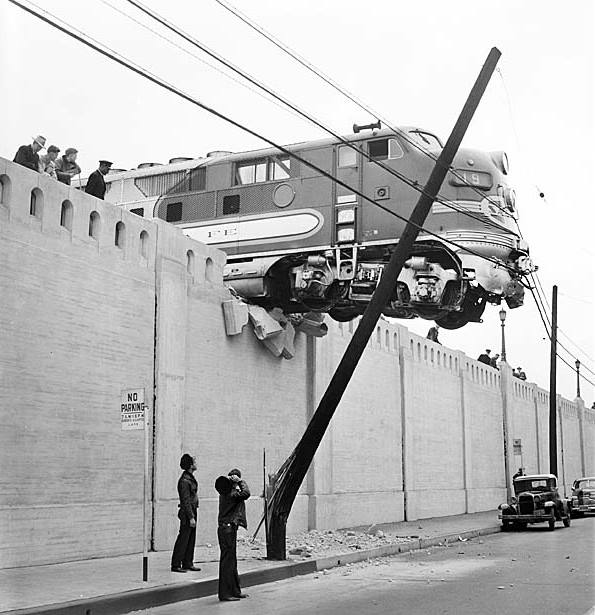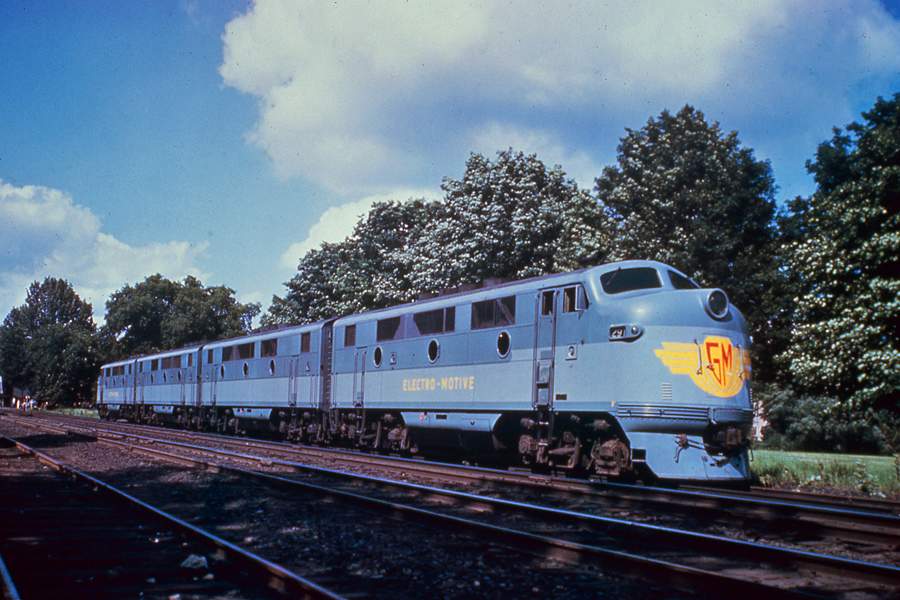- Home ›
- Diesel Locomotives ›
- F3
EMD "F3" Locomotives: Specs, Roster, History
Last revised: February 20, 2025
By: Adam Burns
Electro-Motive's F3 not only continued the builder's success in the main line freight diesel market but also greatly expanded upon it.
Following wartime restrictions, which had prevented EMD from implementing a number of improvements with the original FT, the F3 sold more than 1,800 examples during its four-year production run.
The locomotive could be found in service on nearly all of the major railroads and furthered the industry's efforts to complete dieselization.
Visually, the F3 featured some variations over the earlier FT but generally carried a similar overall appearance, sporting EMD's classic "bull dog" nose streamlining. Its design changes, although never officially distinguished by Electro-Motive, were nevertheless noted by railfans as "phases."
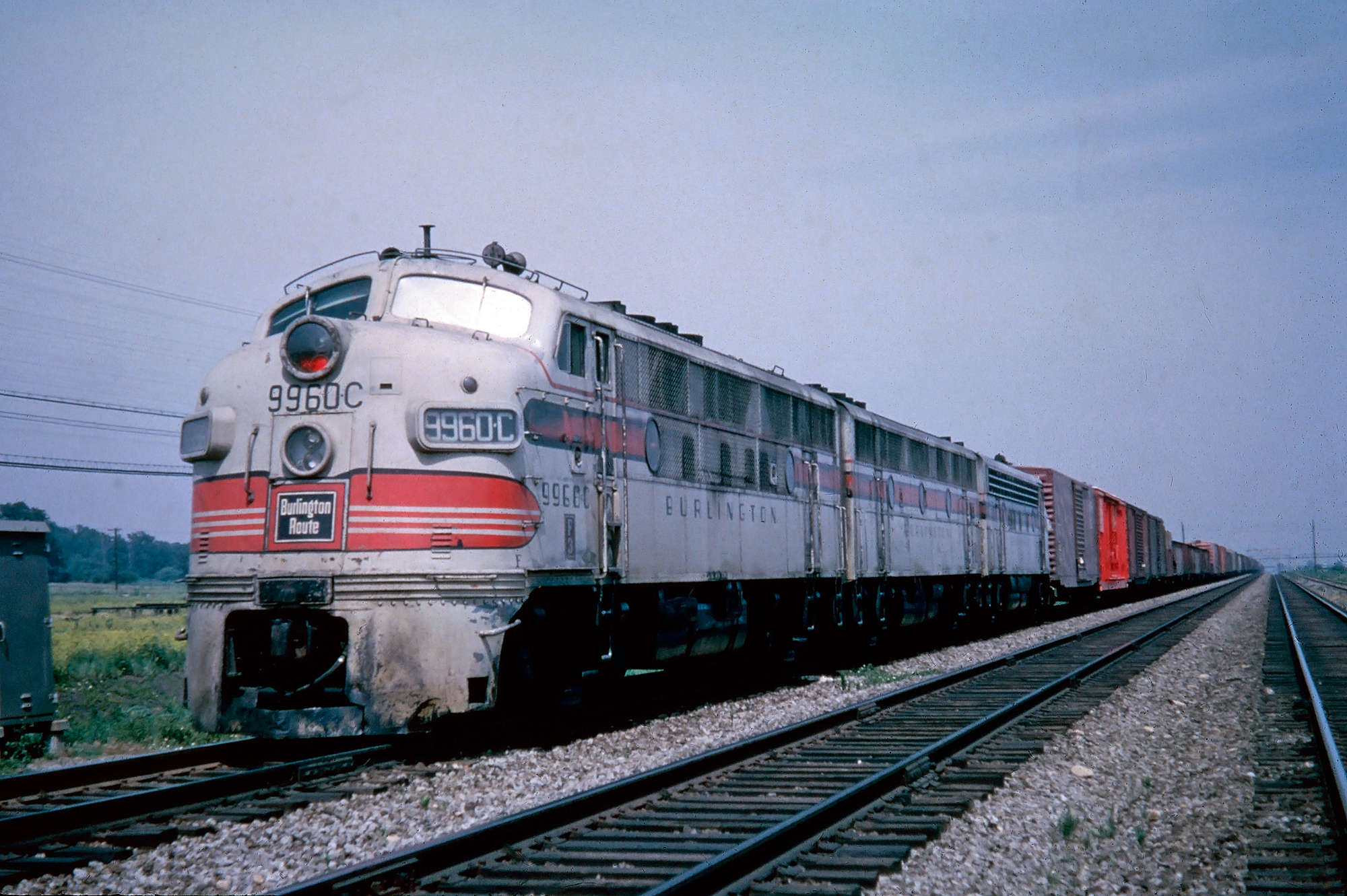 An A-B set of Burlington F3s, led by #9960-C, along with an F7A have a long freight at Eola, Illinois, circa 1964. American-Rails.com collection.
An A-B set of Burlington F3s, led by #9960-C, along with an F7A have a long freight at Eola, Illinois, circa 1964. American-Rails.com collection.Overview
The F3 followed Electro-Motive's earlier F2, a briefly cataloged model built between July-November, 1946 as a stop-gap variant while the builder worked out issues with its latest D12 generator.
Interestingly, the original F3 demonstrators were completed in July, 1945. However, as a result of the D12's issues, mass production did not commence until late 1946. Once ready, sales took off rapidly and the F3 quickly became the best selling road locomotive in North America up until that time.
The model remained cataloged as an A-B-B-A set but could produce an additional 600 horsepower over the FT (6,000 horsepower total); each individual F3 locomotive was rated at 1,500 horsepower, or 150 more than a single unit FT.
As Brian Solomon notes in his book, "Electro-Motive E-Units And F-Units," EMD made a number of other improvements with the F3 in the areas of versatility and performance.
The builder dropped the drawbar arrangement on the FT and equipped each locomotive with standard couplers, thereby providing railroads greater redundancy to utilize each unit however they wished and in whatever grouping they desired. In other words, a two, three, or four unit set was no longer required to operate in tandem.
In addition, the F3 featured electrically-powered appliances in place of belt and mechanical driven variants. Doing so improved reliability and reduced maintenance costs. Finally, the model was equipped with new safety features for improved performance, including a electro-pneumatic throttle control system and automatic engine shutdown (if lubricating oil fell below a predetermined level).
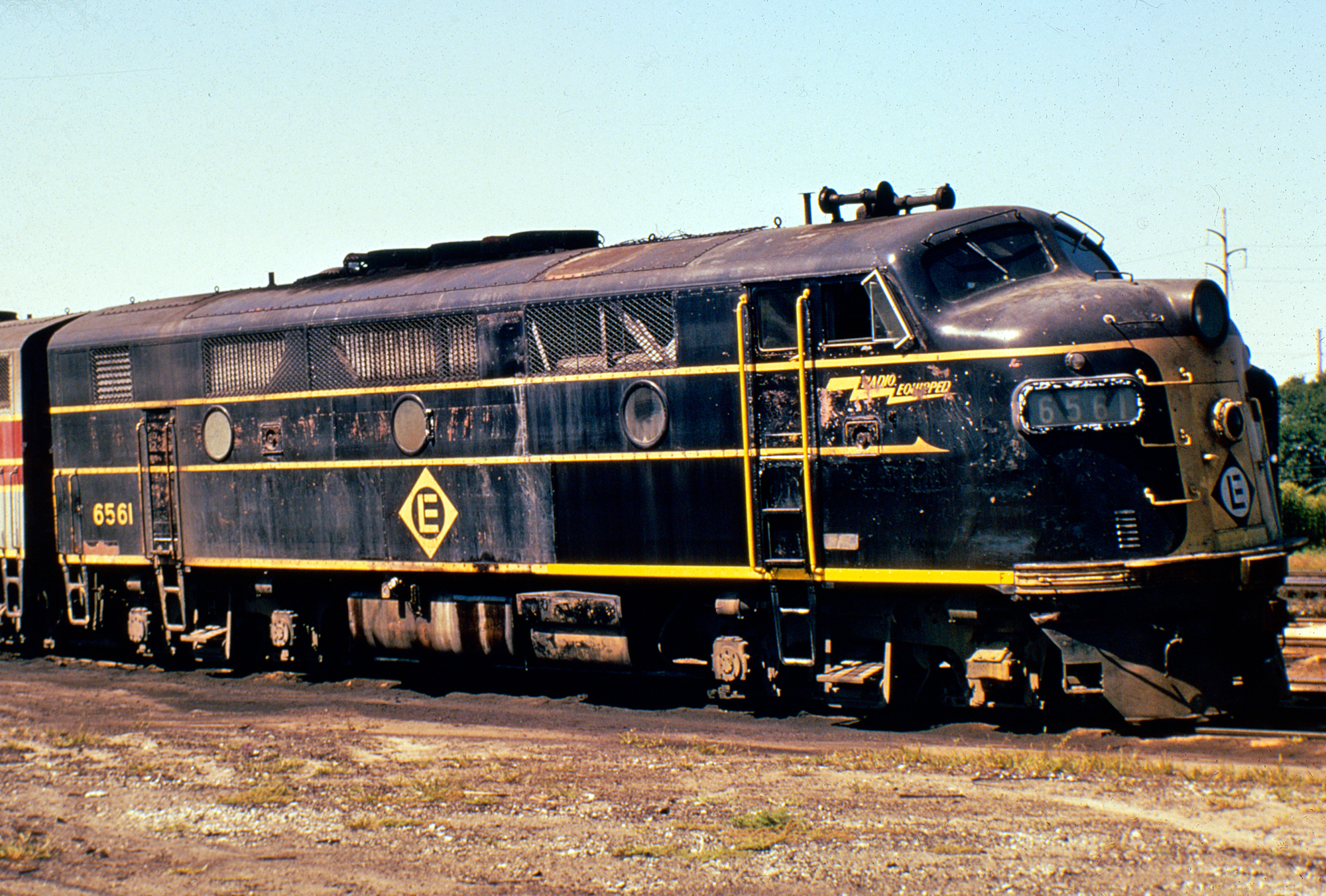 Erie Lackawanna F3A #6561 (ex-Delaware, Lackawanna & Western #656-A), showing her age, at Marion, Ohio; summer, 1970. American-Rails.com collection.
Erie Lackawanna F3A #6561 (ex-Delaware, Lackawanna & Western #656-A), showing her age, at Marion, Ohio; summer, 1970. American-Rails.com collection.The F3 was offered with eight different gearing ratios, ranging from 56:21 for passenger service (top speed of 102 mph while offering 21,000 pounds of continuous tractive effort) to 65:12 for freight duties (a top speed of 50 mph with 42,500 pounds of continuous tractive effort). Typically, railroads ordered F3s with a gearing somewhere between these two extremes.
Externally, the easiest way to identify the FT and F3 is via the number of portholes; the former had four spaced very close together, centered on the carbody while the latter featured just three, and later only two, spaced evenly apart.
At the time of the F3's production, the industry had yet to embrace six-axle, six-motored (C-C truck) locomotives, which offered greater tractive effort and adhesion. This sentiment would begin to change, however, in just over a decade.
Over its four year production run the model saw slight changes to its carbody five different times. However, for the most part, it was identical to the F2 with its most distinguishing feature being larger number boards and fewer portholes. More information about the F3's phases may be found below.
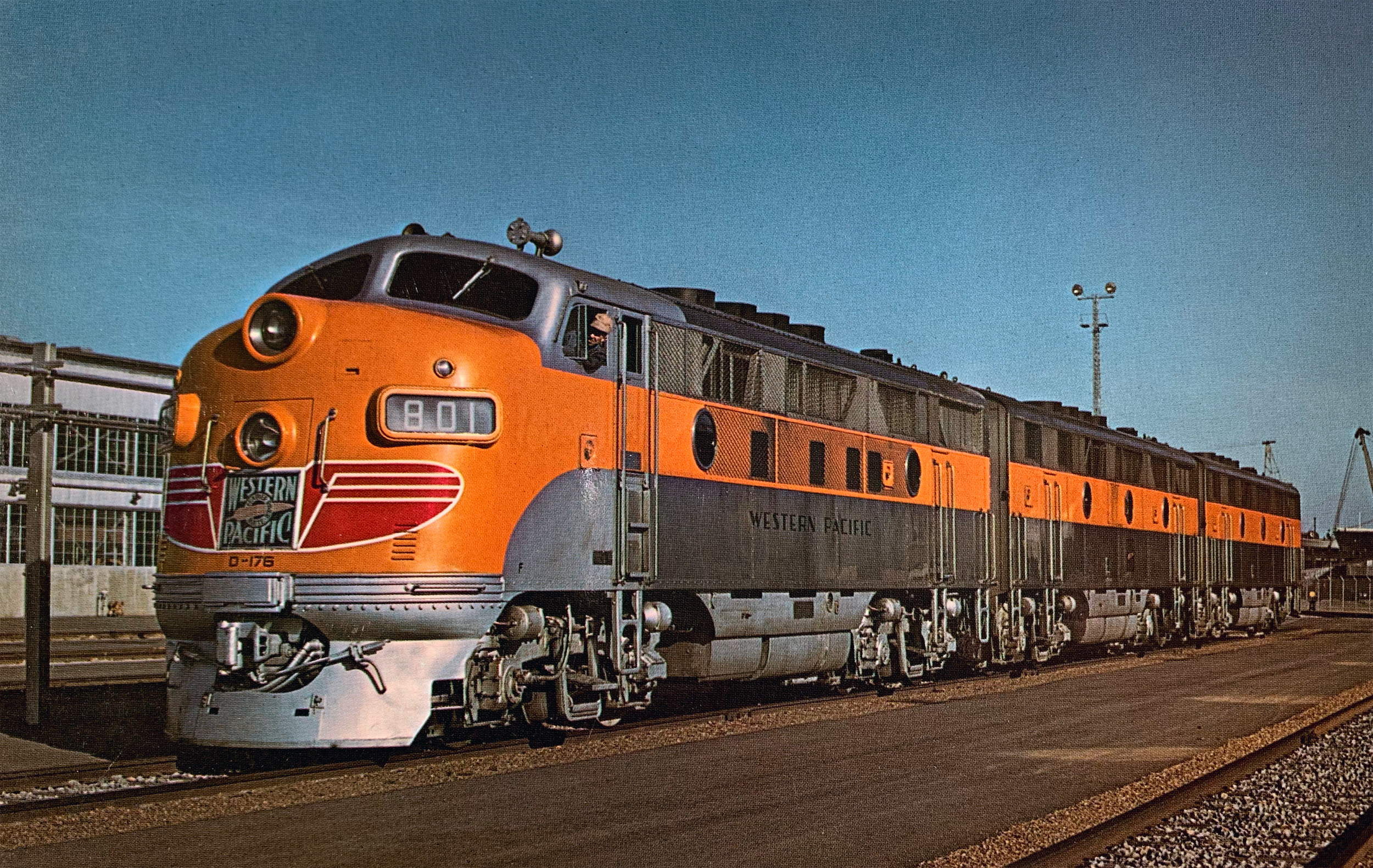 In this Western Pacific publicity scene, new F3's pose for a photo at the Fourth South Yard in Salt Lake City, Utah during the summer of 1947. Author's collection.
In this Western Pacific publicity scene, new F3's pose for a photo at the Fourth South Yard in Salt Lake City, Utah during the summer of 1947. Author's collection.Phases
For railfans there were five different phases; Phase I through Phase V (the latter is also referred to as the "F5"). All of these were extremely minor in nature, mostly involving slight changes to grille locations, radiator fans, portholes, etc.
Specifically the variances include:
- The Phase I variant, which began with the initial F3s completed in October, 1946, was essentially an F2 with upgraded electrical equipment and different number boards.
- The early Phase II model was manufactured from February of 1947 and including slight cosmetic changes including chicken wire used on the top-third of the carbody with wiring used between the two centered portholes.
- The later Phase II went into production that December and sported new radiator fans with a "pan-topped" look.
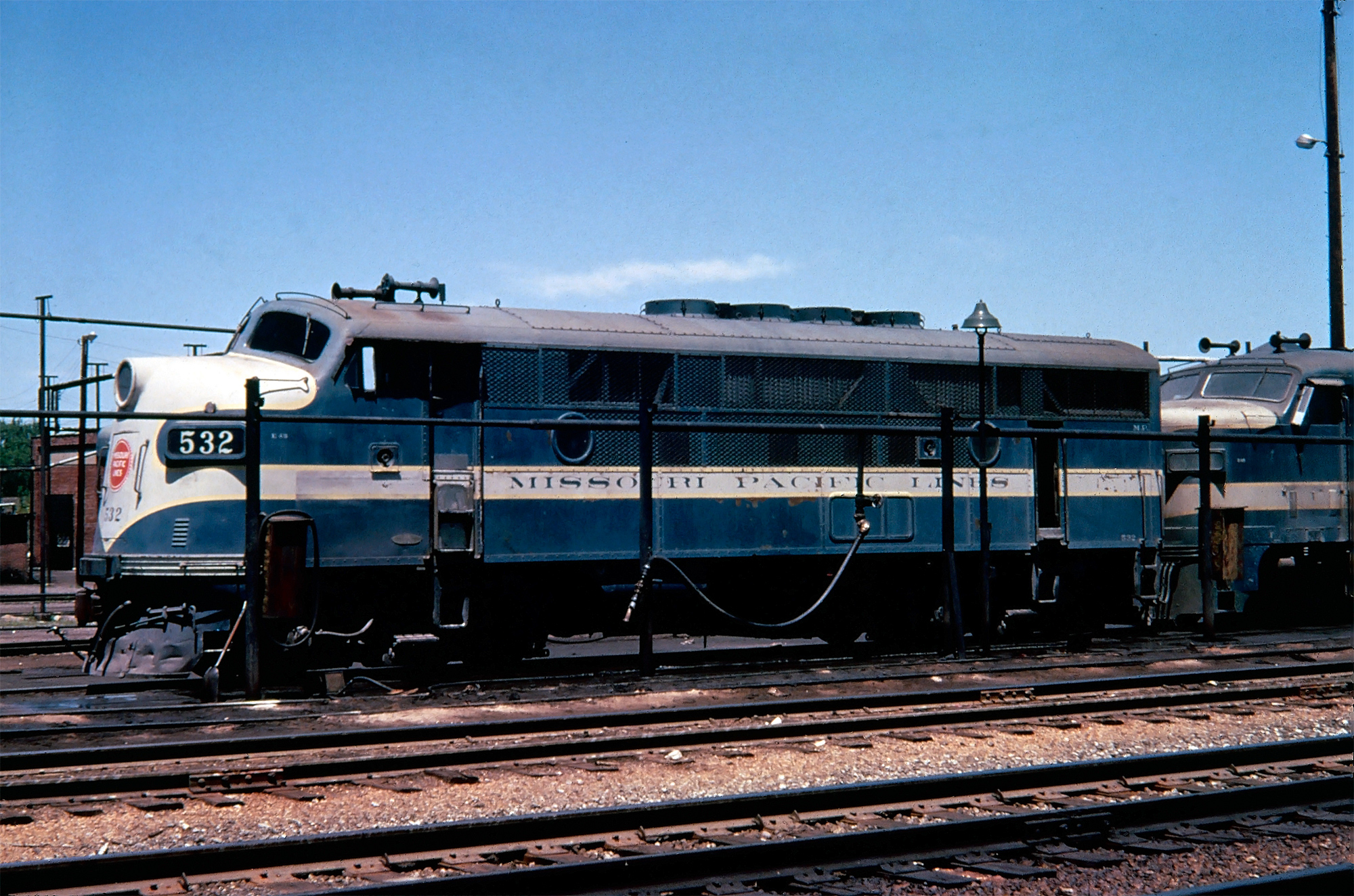 Missouri Pacific F3A #532 (sub-lettered for subsidiary St. Louis, Brownsville & Mexico) and an FA-2 in St. Louis, circa 1955. American-Rails.com collection.
Missouri Pacific F3A #532 (sub-lettered for subsidiary St. Louis, Brownsville & Mexico) and an FA-2 in St. Louis, circa 1955. American-Rails.com collection.The "Flying F3"
The incident which made Santa Fe F3A #19-L a celebrity, and luckily no one was seriously injured. At approximately 8:45 AM on the morning of January 25, 1948 train #17, the combined westbound "El Capitan"/"Super Chief" had just arrived at Los Angeles Union Passenger Terminal.
Author Joe Lesser notes that four trains were scheduled to arrive at LAUPT that morning; Train #19 - "The Chief," Train #3 - "The California Limited," Train #1 - "The Scout," and Train #17 - listed only as "streamliner" on the timetable.
As it turns out Train #21, "The El Capitan," and Train #17, "The Super Chief," were combined as Train #17 at that time into LAUPT.
Upon cutting off from his train, engineer Fred Hurst was following instructions from the herder (a trackman assigned to work station jobs) with his A-B-B-A set of F3's to ease towards the bumping post, prepare to reverse through the crossover, head to the release track, and finally make his way to the roundhouse at nearby Redondo Junction.
As an investigation later discovered, Hurst accidentally turned the F3's MU2A valve, which released air-brake control from the engines.
At this point the locomotives effectively had no brakes and they slowly rolled forward, clipped through the bumper, passed over a 12-foot wide paved road, jumped the curb and sidewalk, and finally smashed through a one-foot thick concrete wall.
Lead locomotive #19-L finally came to rest on its battery case and fuel tank although its front truck dangled over Aliso Street with the unit's nose having snapped a utility pole.
Hurst had remained at the controls the entire time and gingerly made his way out of the back of the locomotive once it came to a stop. However, his fireman, Frank Rittenhouse, had bailed out as soon as he realized something was amiss.
Ultimately, Hurst was found at fault and permanently removed from service. Interestingly, #19-L's adventures did not end here.
It was later involved in a derailment on October 30, 1949; while leading train #22, the eastbound "El Capitan" it struck a broken rail at-speed (60-70 mph) near Azusa, California, rolled over and caught fire. Thankfully, only one crew member and seventeen passengers were slightly injured.
The locomotive was later repaired and returned to service. It was then rebuilt during the CF7 program in the early 1970s and became #2622. In the 1980s it was sold to short line Louisiana & Delta and finally retired in June of 1987.
Many thanks to Joe Lesser's article, "The Case Of Santa Fe's Flying F3" from the March, 2000 issue of Trains Magazine for the historical background concerning this incident.
In 1948 the last three phases of the F3 were produced:
- In March, Phase III began rolling out of La Grange lacking the chicken wire between the centered port holes with louvres included on the four rectangular openings.
- Phase IV was manufactured later that year in August sporting a full-length, stainless-steel grille which replaced the chicken wire at the top of the carbody and made the locomotive closely resemble the later F7.
- Finally there was the "F5" (Phase V) which, again, was never cataloged as a standalone model by EMD; built between October, 1948 through February, 1949 the locomotive's notable feature was the new model D27C traction motor. While more rugged, the F5 retained the same, overall tractive effort rating.
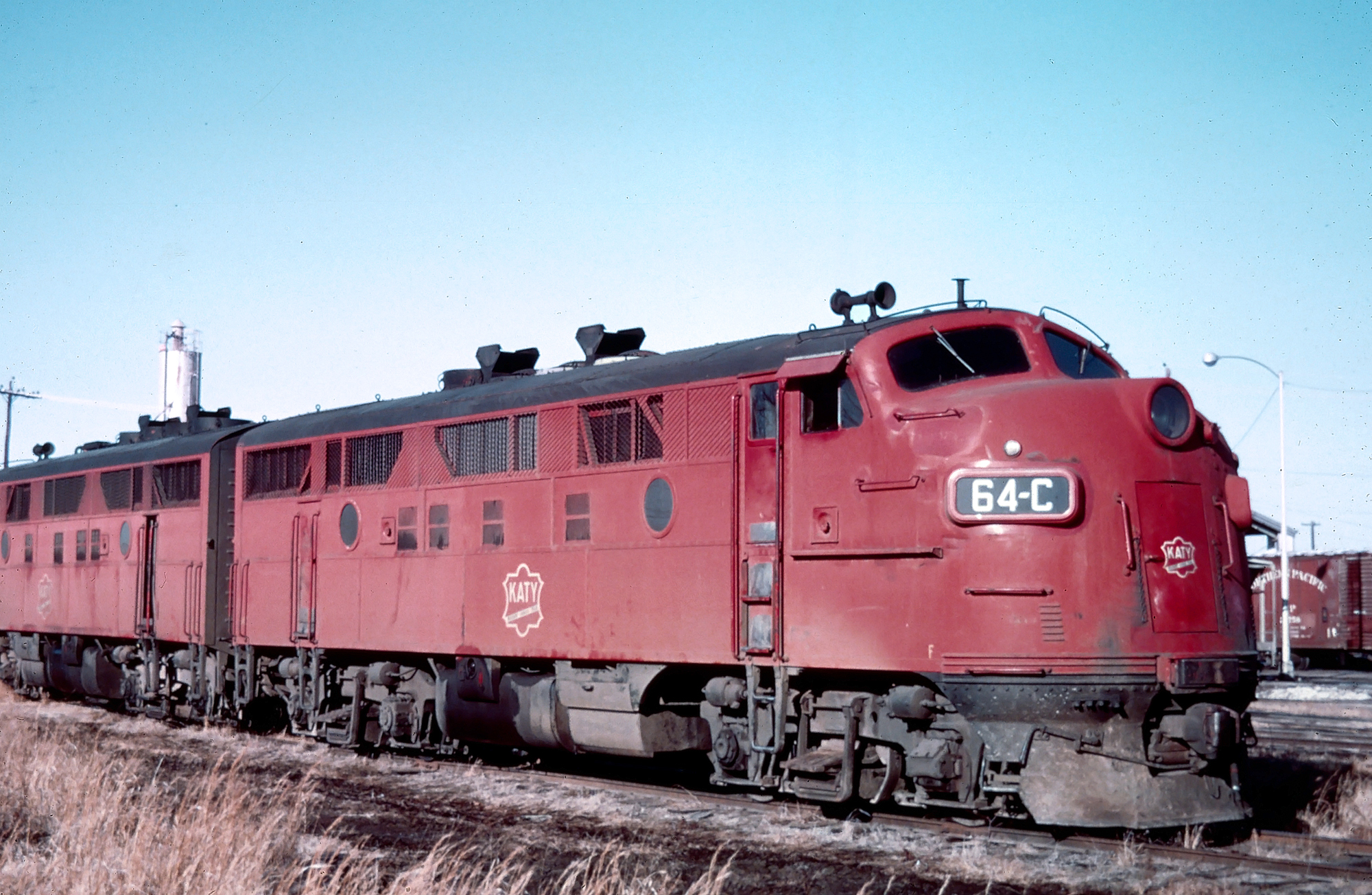 Missouri-Kansas-Texas (Katy) F3A's #64-C and #65-C at Parsons, Kansas, circa 1966. Mac Owen photo. American-Rails.com collection.
Missouri-Kansas-Texas (Katy) F3A's #64-C and #65-C at Parsons, Kansas, circa 1966. Mac Owen photo. American-Rails.com collection.Data Sheet and Specifications
| Entered Production | 7/1945 (Demonstrator set #291) |
| Years Produced | 7/1945 - 2/1949 |
| Engine | 567B |
| Engine Builder | GM |
| Horsepower | 1500 |
| RPM | 800 |
| Cylinders | 16 |
| Length (F3A) | 50' 8" |
| Length (F3B) | 50' 0" |
| Height (Top Of Rail To Top Of Horn) | 15' 0" (F3A) |
| Height (Top Of Rail To Top Of Exhaust Fans) | 14' 8" (F3B) |
| Width | 10' 7" |
| Weight | 230,000 Lbs (A Units): 228,000 Lbs (B Units, Phase V only) |
| Fuel Capacity | 1,200 Gallons |
| Air Compressor | Gardner-Denver |
| Air Compressor Model | WBO |
| Air Brake Manufacturer | Westinghouse |
| Air Brake Schedule | 24RL |
| Trucks | B-B |
| Truck Type | Blomberg |
| Truck Wheelbase | 9' |
| Wheel Size | 40" |
| Traction Motors | D27B/C (4), GM |
| Primary Generator | D12, GM |
| Auxiliary Generator | Delco (A8102) |
| Alternator | D14 |
| MU (Multiple-Unit) | Yes |
| Dynamic Brakes | Yes |
| Gear Ratios | 65:12, 62:15, 61:16, 60:17, 59:18, 58:19, 57:20, 56:21 |
| Tractive Efforts (Continuous, at 11 mph) | 52,400; 40,000; 37,000; 34,000; 32,000; 29,500; 27,500; 25,500 |
| Top Speeds | 55 mph, 65 mph, 71 mph, 77 mph, 83 mph, 95 mph, 102 mph |
* Steam generators were optional in the F3. They were produced by Vapor Clarkson, model OK4616 (1,200 Lbs/Hr).
Production Rosters
F3A
Total Built = 1,107
| Owner | Road Number | Serial Number | Order Number | Completion Date |
|---|---|---|---|---|
| Santa Fe | 16, 16C - 21, 21C | 2729-2740 | E630 | 10/1946 - 11/1946 |
| New York, Ontario & Western | 821-822 | 3142-3143 | E825 | 3/1948 |
| New York, Ontario & Western | 501-503 | 3146-3148 | E825 | 1/1948 - 3/1948 |
| Electro-Motive (Demonstrator) | 291A1 (became Toledo, Peoria & Western 100A) | 3370 | E673 | 7/1945 |
| Electro-Motive (Demonstrator) | 291A2 (destroyed in accident, never sold) | 3371 | E673 | 7/1945 |
| Southern (Alabama Great Southern) | 6702-6705 | 3378-3381 | E675 | 11/1946 |
| Great Northern | 225-227 | 3489-3491 | E688 | 11/1946 |
| Denver & Rio Grande Western | 552 - 554 (1st and 4th units in A-B-B-A set) | 3544-3549 | E692 | 11/1946 |
| Southern | 4128-4143 | 3556-3571 | E693 | 11/1946 - 12/1946 |
| Gulf, Mobile & Ohio | 800A/800B - 806A/806B, 880A/880B - 882A/882B | 3586-3605 | E695 | 12/1946 |
| Chicago, Indianapolis & Louisville (Monon) | 51A, 51B - 52A, 52B | 3663-3666 | E703 | 12/1946 |
| Chicago, Indianapolis & Louisville (Monon) | 61A, 61B - 64A, 64B | 3669-3676 | E704 | 12/1946 - 1/1947 |
| Delaware, Lackawanna & Western | 801A, 801C - 802A, 802C | 3717-3720 | E710 | 12/1946 |
| Delaware, Lackawanna & Western | 605A, 605C - 606A, 606C | 3723-3726 | E763 | 12/1946 |
| Delaware, Lackawanna & Western | 655A-656A | 3729-3730 | E711 | 1/1947 |
| Northern Pacific | 6500A-6505A | 3773-3778 | E722 | 1/1947 |
| Northern Pacific | 6011A, 6011D - 6014A, 6014D | 3779-3786 | E759 | 1/1947 |
| Southern | 4144-4170 | 3797-3823 | E723 | 1/1947 - 2/1947 |
| Southern (New Orleans & North Eastern) | 6804-6806 | 3837-3839 | E733 | 4/1947 |
| Southern (Alabama Great Southern) | 6706-6713 | 3841-3848 | E734 | 4/1947 - 5/1947 |
| Southern (Cincinnati, New Orleans & Texas Pacific) | 6106-6113 | 3853-3860 | E735 | 5/1947 |
| Kansas City Southern | 50A, 50D - 51A, 51D | 3897-3900 | E731 | 1/1947 |
| Kansas City Southern | 52A, 52D - 53A, 53D | 3901-3904 | E731 | 5/1947 |
| Kansas City Southern | 30A-31A | 3905-3906 | E777 | 11/1947 |
| Western Pacific | 801-803A | 3925-3927 | E737 | 6/1947 |
| Gulf, Mobile & Ohio | 807A/807B - 810A/810B, 811A | 3942-3950 | E740 | 5/1947 - 6/1947 |
| Chicago & North Western | 4051C-4054C | 3965-3968 | E743 | 1/1947 |
| Chicago & North Western | 4055A, 4055C | 3969-3970 | E743 | 6/1947 |
| Missouri-Kansas-Texas (Katy) | 201A-207A, 201C-207C | 4025-4038 | E749 | 6/1947 |
| Central Railroad of New Jersey | 50-59 | 4046-4055 | E750 | 7/1947 |
| Electro-Motive (Demonstrators) | 754A1, 754A2 (became Chicago, Indianapolis & Louisville [Monon] 85A, 85B) | 4065-4066 | E754 | 9/1946 |
| Baltimore & Ohio | 82/82A - 86/86A (Evens), 88 | 4072-4078 | E757 | 7/1947 |
| Erie Railroad | 800A, 800D - 806A, 806D | 4086-4099 | E760 | 7/1947 |
| Chicago Great Western | 101A, 101C - 106A, 106C | 4117-4128 | E762 | 10/1947 |
| New York Central | 1606-1623 | 4183-4200 | E752 | 6/1947 - 7/1947 |
| New York Central | 3500-3503 | 4211-4214 | E772 | 7/1947 |
| Missouri Pacific | 513, 519, 514, 520, 515, 521, 516, 522, 517, 523, 518, 524 | 4234-4245 | E775 | 11/1947 |
| Kansas City Southern | 54A, 54D | 4256-4257 | E778 | 5/1947 |
| Chicago & North Western | 4057A/4057C - 4063A/4063C, 4065A, 4065C | 4288-4303 | E782 | 12/1947 |
| Northern Pacific | 6015A, 6015D | 4312-4313 | E759 | 1/1947 |
| Great Northern | 260A-261A | 4334-4335 | E800 | 10/1947 |
| Great Northern | 259A, 259B | 4341-4342 | E798 | 10/1947 |
| Great Northern | 262A, 262B - 263A, 263B | 4343-4346 | E799 | 9/1947 |
| Great Northern | 228-231 | 4355-4358 | E802 | 10/1947 |
| Missouri Pacific (St Louis, Brownsville & Mexico) | 529-540 | 4359-4370 | E784 | 11/1947 |
| Missouri Pacific (International-Great Northern) | 525, 527, 526, 528 | 4371-4374 | E785 | 11/1947 |
| Erie Railroad | 706A, 706D - 708A, 708D | 4377-4382 | E786 | 11/1947 |
| Delaware, Lackawanna & Western | 803A, 803C - 805A, 805C | 4395-4400 | E789 | 12/1947 |
| Chicago, Burlington & Quincy | 116A, 116D - 120A, 120D | 4404-4413 | E790 | 10/1947 |
| Chicago, Burlington & Quincy | 9960A, 9960C - 9962A, 9962C | 4424-4429 | E791 | 10/1947 |
| Chicago, Indianapolis & Louisville (Monon) | 81A, 81B-84A, 84B | 4453-4460 | E796 | 5/1947 |
| Chicago & North Western | 4056A, 4056C, 4064A, 4064C | 4461-4464 | E867 | 2/1947 |
| Chicago, Burlington & Quincy | 121A, 121D | 4465-4466 | E790 | 11/1947 |
| Chicago, Burlington & Quincy | 160A, 160C - 161A, 161C | 4469-4472 | E797 | 11/1947 |
| Central of Georgia | 901-904 | 4475-4478 | E803 | 12/1947 |
| Union Pacific | 964A-968A | 4480-4484 | E845 | 9/1947 |
| Maine Central | 671A-672A | 4494-4495 | E809 | 12/1947 |
| Southern Pacific | 6100A, 6100D - 6101A, 6101D | 4502-4505 | E811 | 5/1947 |
| Southern Pacific | 6102A, 6102D - 6119A, 6119D | 4506-4541 | E811 | 10/1947 - 1/1948 |
| Delaware, Lackawanna & Western | 621A, 621C | 4595-4596 | E1002 | 1/1948 |
| Aberdeen & Rockfish | 200 | 4598 | E816 | 4/1947 |
| Spokane, Portland & Seattle | 800A1, 800A2 | 4599-4600 | E817 | 4/1947 |
| Union Pacific | 1400A-1403A | 4601-4604 | E818 | 5/1947 |
| Union Pacific | 1404A-1409A | 4609-4614 | E818 | 10/47 |
| Union Pacific | 1410A-1441A | 4615-4646 | E818 | 1/1948 - 3/1948 |
| Great Northern | 350A-358A, 350C-358C | 4673-4690 | E819 | 11/1947 - 12/1947 |
| Seaboard Air Line | 4022-4027 | 4737-4742 | E826 | 3/1948 |
| Northern Pacific | 6506A | 4787 | E722 | 4/1947 |
| Great Northern | 430A, 430D - 438A, 438D (Evens) | 4805-4812 | E836 | 8/1948 - 9/1948 |
| Great Northern | 306A, 306C | 4821-4822 | E1099 | 10/1948 |
| Great Northern | 264A, 264B - 265A, 265B | 4826-4829 | E1100 | 10/1948 |
| Great Northern | 266A-267A | 4830-4831 | E1101 | 10/1948 |
| Great Northern | 375C-376C | 4834-4835 | E1102 | 10/1948 |
| New York Central | 1624-1635 | 4859-4870 | E841 | 4/1948 |
| Pennsylvania | 9500A-9503A | 4914-4917 | E843 | 7/1947 |
| Kansas City Southern (Louisiana & Arkansas) | 55A, 55D - 58A, 58D | 4924-4931 | E844 | 3/1948 |
| Minneapolis & St Louis | 248A, 249C, 348A, 348C, 448A, 448C | 4948-4953 | E848 | 3/1948 |
| Delaware, Lackawanna & Western | 657A-662A | 4973-4978 | E853 | 3/1948 |
| Gulf, Mobile & Ohio | 883A-885A | 4996-4998 | E857 | 6/1947 |
| Chicago Great Western | 107A, 107C - 112A, 112C | 5004-5015 | E858 | 3/1948 |
| Pennsylvania | 9506A-9517A | 5043-5054 | E863 | 4/1948 - 5/1948 |
| Baltimore & Ohio | 113, 113A - 151, 151A (Odds) | 5089-5128 | E865 | 4/1948 - 5/1948 |
| Atlanta & St Andrews Bay | 1501 | 5144 | E870 | 6/1947 |
| Western Maryland | 51-52 | 5145-5146 | E871 | 6/1947 |
| Bangor & Aroostook | 500A-503A | 5170-5173 | E875 | 10/1947 |
| Bangor & Aroostook | 504A-505A | 5174-5175 | E875 | 5/1948 |
| Bangor & Aroostook | 506A-507A | 5180-5181 | E876 | 5/1948 |
| Central of Georgia | 905-908 | 5198-5201 | E881 | 5/1948 |
| Grand Trunk Western | 9006-9015 | 5205-5214 | E883 | 5/1948 |
| Grand Trunk Western | 9016-9027 | 5215-5226 | E883 | 9/1948 |
| Southern | 4171-4172 | 5281-5282 | E869 | 6/1947 |
| St Louis-San Francisco Railway (Frisco) | 5000-5001 | 5310-5311 | E895 | 1/1948 |
| St Louis-San Francisco Railway (Frisco) | 5002-5017 | 5312-5327 | E895 | 5/1948 - 6/1948 |
| Pennsylvania | 9520A-9527A, 9540A-9541A, 9528A | 5346-5355, 5358 | E896 | 5/1948, 7/1948 |
| Pennsylvania | 9504A-9505A | 5389-5390 | E922 | 9/1947 |
| Chicago & North Western | 4066A, 4066C | 5391-5392 | E782 | 12/1947 |
| Santa Fe | 22, 22C - 29, 29C | 5397-5412 | E902 | 3/1948 - 6/1948 |
| Missouri Pacific | 561, 571, 562, 572, 563, 573, 564, 574, 565, 575, 566, 576 | 5417-5428 | E903 | 8/1948 |
| Missouri Pacific | 567-570 | 5435-5438 | E904 | 9/1948 |
| Missouri Pacific (St Louis, Brownsville & Mexico) | 541-552 | 5459-5470 | E907 | 6/1948 |
| Missouri Pacific (International-Great Northern) | 553, 557, 554, 558, 555, 559, 556, 560 | 5471-5478 | E908 | 9/1948 |
| Florida East Coast | 501-508 | 5516-5523 | E913 | 1/1949 |
| Soo Line | 200A, 200B | 5545-5546 | E917 | 10/1947 |
| Soo Line | 201A, 201B - 202A, 202B | 5547-5550 | E917 | 1/1948 |
| Soo Line | 203A, 203B - 204A, 204B | 5551-5554 | E917 | 9/1948 |
| Pennsylvania | 9529A-9539A, 9556A-9565A | 5577-5596 | E921 | 9/1948 |
| Boston & Maine | 4227A-4228A | 5601-5602 | E925 | 10/1948 |
| Seaboard Air Line | 4028-4032 | 5657-5661 | E826 | 3/1948 |
| Atlantic Coast Line | 336-347 | 5683-5694 | E936 | 12/1948 |
| Maine Central | 681-686 | 5695-5700 | E937 | 11/1948 |
| Union Pacific | 1442-1456 | 5707-5721 | E939 | 4/1948 - 9/1948 |
| Baltimore & Ohio | 153, 153A - 171, 171A (Odds) | 5722-5741 | E940 | 11/1948- 1/1949 |
| Pennsylvania | 9566A-9567A | 5748-5749 | E921 | 9/1948 |
| Nashville, Chattanooga & St Louis | 800 | 5772 | E951 | 3/1948 |
| Nashville, Chattanooga & St Louis | 801 | 5773 | E951 | 7/1948 |
| Nashville, Chattanooga & St Louis | 802-804 | 5774-5776 | E951 | 12/1948 |
| Nashville, Chattanooga & St Louis | 805-806 | 5787-5788 | E1072 | 8/1948 |
| Nashville, Chattanooga & St Louis | 807-808 | 5789-5790 | E1073 | 1/1949 |
| Southern | 4180-4189, 4173-4177 | 5847-5861 | E955 | 11/1948 - 1/1949 |
| Denver & Rio Grande Western | 556 (1st and 4th units in A-B-B-A set) | 5864-5865 | E956 | 11/1948 |
| Chicago, Burlington & Quincy | 122A, 122D - 128A, 128D | 5874-5887 | E957 | 4/1948 - 8/1948 |
| Southern | 4178-4179, 4200-4202, 4190-4199 | 5923-5937 | E955 | 1/1949 |
| Chicago Great Western | 113A, 113C - 115A, 113C | 5989-5994 | E963 | 2/1949 |
| Chicago Great Western | 150-152 | 5995-5997 | E964 | 11/1948, 1/1949 |
| Chicago & Eastern Illinois | 1406-1409 | 5998-6001 | E965 | 12/1948 |
| Chicago & Eastern Illinois | 1204-1205 | 6004-6005 | E1111 | 2/1949 |
| Chicago & Eastern Illinois | 1400-1403 | 6006-6009 | E1096 | 7/1948 |
| Chicago & Eastern Illinois | 1200-1203 | 6018-6021 | E967 | 2/1948 |
| Reading | 260A-265A | 6182-6187 | E982 | 11/1948 |
| Milwaukee Road | 80A, 80D | 6307-6308 | E1211 | 1/1949 |
| Milwaukee Road | 81A, 81D - 83A, 83D | 6309-6314 | E997 | 1/1949 - 2/1949 |
| Union Pacific | 1457-1461 | 6331-6335 | E939 | 9/1948 |
| Pennsylvania | 9542A-9555A | 6467-6480 | E1004 | 10/1948 - 1/1949 |
| Pennsylvania | 9679A | 6488 | E1108 | 10/1948 |
| Pennsylvania | 9680A-9683A | 6489-6492 | E1108 | 1/1949 - 2/1949 |
| Pennsylvania | 9518A-9519A | 6496-6497 | E1021 | 1/1948 |
| Chicago, Burlington & Quincy | 162A, 162C | 6506-6507 | E1007 | 6/1948 |
| Chicago, Burlington & Quincy | 129A, 129D | 6561-6562 | E957 | 8/1948 |
| Santa Fe | 30, 30C - 36, 36C | E1014 | 6613-6626 | 8/1948 - 1/1949 |
| Northern Pacific | 6503C-6506C, 6016A/6016D-6017A/6017D | 6652-6659 | E1018 | 10/1948 |
| Union Pacific | 905-910 | 6660-6665 | E1019 | 5/1948 - 6/1948 |
| Union Pacific | 1462-1463, 1550-1563 | 6713-6728 | E939 | 9/1948 - 1/1949 |
| Southern Pacific | 6120A, 6120D - 6139A, 6139D | 6903-6942 | E1035 | 10/1948 - 2/1949 |
| Central of Georgia | 909 | 6993 | E881 | 5/1948 |
| Chicago, Burlington & Quincy | 130A/130D-131A/131D, 137A/137D-138A/138D, 134A/134D-136A/136D | 7006-7019 | E957 | 10-11/1948 |
| Chicago, Burlington & Quincy | 132A, 132D - 133A, 133D | 7050-7053 | E957 | 11/1948, 1/1949 |
| Soo Line (Wisconsin Central) | 2200A, 2200B | 7403-7404 | E1053 | 9/1948 |
| Chicago, Indianapolis & Louisville (Monon) | 62B, 64A | 7416-7417 | E1055 | 4/1948 |
| Louisville & Nashville | 2500-2501 | 7453-7454 | E1060 | 8/1948 |
| Electro-Motive (Demonstrator) | 951 (became Kansas City Southern [Louisiana & Arkansas] 59A | 7459 | E1215 | 10/1948 |
| Erie | 709A, 709D - 710A, 710D | 7465-7468 | E1063 | 2/1949 |
| Georgia | 1001 | 7483 | E1065 | 10/1948 |
| Pennsylvania | 9684A-9689A | 7574-7579 | E1080 | 2/1949 |
| Western Railway of Alabama | 501 | 7604 | E1083 | 9/1948 |
| Spokane, Portland & Seattle | 802 | 7798 | E1103 | 11/1948 |
| Santa Fe | 200, 200C - 201, 201C | 7799-7802 | E1104 | 10-11/1948 |
| Aberdeen & Rock Fish | 201 | 7811 | E1107 | 11/1948 |
| Chicago & Eastern Illinois | 1404-1405 | 7850-7851 | E1119 | 11/1948 |
| Great Northern | 438A, 438D | 8014-8015 | E836 | 10/1948 |
| Lehigh Valley | 510-528 (Evens) | 8167-8176 | E1143 | 10/1948 - 11/1948 |
| Southern | 4203-4206 | 8275-8278 | E1151 | 1/1949 |
| Pennsylvania | 9677A-9678A | 8279-8280 | E921 | 9/1948 |
| Clinchfield | 800-803 | 8479-8482 | E1175 | 12/1948 |
| Clinchfield | 804-805 | 8483-8484 | E1175 | 2/1949 |
F3B
Total Built = 694
| Owner | Road Number | Serial Number | Order Number | Completion Date |
|---|---|---|---|---|
| Santa Fe | 16A, 16B - 21A, 21B | 2741-2752 | E630 | 10/1946-11/1946 |
| New York, Ontario & Western | 821B-822B | 3144-3145 | E825 | 3/1948 |
| Electro-Motive (Demonstrator) | 291B1 (became Toledo, Peoria & Western 100B) | 3372 | E673 | 7/1945 |
| Electro-Motive (Demonstrator) | 291B2, renumbered 754B1 (became Chicago, Indianapolis & Louisville [Monon] 65C) | 3373 | E754 | 7/1945 |
| Southern (Alabama Great Southern) | 6750-6751 | 3382-3383 | E675 | 11/1946 |
| Denver & Rio Grande Western | 552-554 (2nd and 3rd units in A-B-B-A set) | 3550-3555 | E692 | 11/1946 |
| Southern | 4320-4327 | 3572-3579 | E693 | 12/1946 |
| Chicago, Indianapolis & Louisville (Monon) | 61C-62C | 3677-3678 | E704 | 12/1946 |
| Delaware, Lackawanna & Western | 801B-802B | 3721-3722 | E710 | 12/1946 |
| Delaware, Lackawanna & Western | 605B-606B | 3727-3728 | E763 | 12/1946 |
| Delaware, Lackawanna & Western | 655B-656B | 3731-3732 | E711 | 1/1947 |
| Northern Pacific | 6500B, 6500C - 6504B, 6504C | 3787-3796 | E722 | 1/1947 |
| Southern | 4328-4340 | 3824-3836 | E723 | 1/1947- 2/1947 |
| Southern (New Orleans & North Eastern) | 6829 | 3840 | E733 | 4/1947 |
| Southern (Alabama Great Southern) | 6752-6755 | 3849-3852 | E734 | 4/1947 - 5/1947 |
| Southern (Cincinnati, New Orleans & Texas Pacific) | 6156-6159 | 3861-3864 | E735 | 5/1947 |
| Northern Pacific | 6505B, 6505C | 3872-3873 | E722 | 1/1947 |
| Northern Pacific | 6011B, 6011C - 6015B, 6015C | 3874-3883 | E759 | 1/1947 |
| Kansas City Southern | 50B, 50C - 51B, 51C | 3907-3910 | E731 | 1/1947 |
| Kansas City Southern | 52B, 52C - 53B, 53C | 3911-3914 | E731 | 5/1947 |
| Kansas City Southern | 30B-31B | 3915-3916 | E777 | 11/1947 |
| Western Pacific | 801B, 801C - 803B, 803C | 3928-3933 | E737 | 6/1947 |
| Gulf, Mobile & Ohio | B60-B64 | 3957-3961 | E740 | 5/1947 - 6/1947 |
| Chicago & North Western | 4055B | 3971 | E743 | 6/1947 |
| Missouri-Kansas-Texas | 201B-207B | 4039-4045 | E749 | 6/1947 |
| Central of New Jersey | A-E | 4056-4060 | E750 | 7/1947 |
| Chicago, Indianapolis & Louisville (Monon) | 63C-64C | 4067-4068 | E704 | 1/1947 |
| Baltimore & Ohio | 82x, 82Ax, 84x, 84Ax | 4080-4083 | E757 | 7/1947 |
| Erie | 800B-806B | 4100-4106 | E760 | 7/1947 |
| Chicago Great Western | 101B-106B | 4129-4134 | E762 | 10/1947 |
| Baltimore & Ohio | 86x, 86Ax, 88x | 4135-4137 | E757 | 7/1947 |
| New York Central | 2404-2413 | 4201-4210 | E752 | 6/1947 - 7/1947 |
| New York Central | 3600-3601 | 4215-4216 | E772 | 7/1947 |
| Missouri Pacific | 513B-518B | 4246-4251 | E775 | 11/1947 |
| Kansas City Southern | 54B, 54C | 4260-4261 | E778 | 5/1947 |
| Chicago & North Western | 4057B-4063B, 4065B | 4304-4311 | E782 | 12/1947 |
| Great Northern | 260B-261B | 4336-4337 | E800 | 10/1947 |
| Missouri Pacific (International-Great Northern) | 525B-526B | 4375-4376 | E785 | 11/1947 |
| Erie | 706B, 706C-708B, 708C | 4383-4388 | E786 | 11/1947 |
| Delaware, Lackawanna & Western | 803B-805B | 4401-4403 | E789 | 12/1947 |
| Chicago, Burlington & Quincy | 116B, 116C - 120B, 120C | 4414-4423 | E790 | 10/1947 |
| Chicago, Burlington & Quincy | 9960B-9962B | 4430-4432 | E791 | 10/1947 |
| Chicago, Burlington & Quincy | 121B, 121C | 4467-4468 | E790 | 11/1947 |
| Chicago, Burlington & Quincy | 160B-161B | 4473-4474 | E797 | 11/1947 |
| Union Pacific | 969B-975B | 4485-4491 | E845 | 9/1947 |
| Maine Central | 671B-672B | 4496-4497 | E809 | 12/1947 |
| Southern Pacific | 6100B, 6100C- 6119B, 6119C | 4542-4581 | E811 | 5/1947 - 1/1948 |
| Delaware, Lackawanna & Western | 622B | 4597 | E1002 | 1/1948 |
| Union Pacific | 1442B-1445B | 4605-4608 | E818 | 5/1947 |
| Union Pacific | 1446B-1451B | 4647-4652 | E818 | 10/1947 |
| Union Pacific | 1452B-1471B | 4653-4672 | E818 | 1/1948 - 3/1948 |
| Great Northern | 350B-355B | 4691-4696 | E819 | 11/1947 - 12/1947 |
| Great Northern | 356B-358B | 4734-4736 | E819 | 12/1947 |
| Northern Pacific | 6506B, 6506C | 4788-4789 | E722 | 4/1947 |
| Great Northern | 430B, 430C - 436B, 436C (Evens) | 4813-4820 | E836 | 8/1948-9/1948 |
| Great Northern | 306B | 4825 | E1099 | 10/1948 |
| Great Northern | 266B-267B | 4832-4833 | E1101 | 10/1948 |
| Union Pacific | 976B-978B | 4842-4844 | E845 | 9/1947 |
| New York Central | 2414-2419 | 4871-4876 | E841 | 4/1948 |
| Pennsylvania | 9500B-9503B | 4918-4921 | E843 | 7/1947 |
| Pennsylvania | 9504B-9505B | 4922-4923 | E922 | 9/1947 |
| Kansas City Southern | 55B, 55C - 58B, 58C | 4932-4939 | E844 | 3/1948 |
| Delaware, Lackawanna & Western | 657B-662B | 4979-4984 | E853 | 3/1948 |
| Gulf Mobile & Ohio | B80-B82 | 4999-5001 | E857 | 6/1947 |
| Chicago Great Western | 107B-112B | 5016-5021 | E858 | 3/1948 |
| Pennsylvania | 9506B-9517B | 5055-5066 | E863 | 4/1948 - 5/1948 |
| Pennsylvania | 9523B-9527B, 9540B | 5067-5072 | E896 | 7/1948 |
| Bangor & Aroostook | 600B-601B | 5176-5177 | E875 | 10/1947 |
| Bangor & Aroostook | 602B-603B | 5178-5179 | E875 | 5/1948 |
| Southern | 4341-4352 | 5182-5193 | E877 | 10/1947 - 11/1947 |
| Chicago, Indianapolis & Louisville (Monon) | 64C | 5194 | E878 | 10/1947 |
| Chicago Great Western | 101D-104D | 5234-5237 | E963 | 2/1949 |
| Southern | 4353-4354 | 5283-5284 | E869 | 6/1947 |
| St Louis-San Francisco Railway (Frisco) | 5100-5101 | 5328-5329 | E895 | 1/1948 |
| St Louis-San Francisco Railway (Frisco) | 5102-5117 | 5330-5345 | E895 | 5/1948 - 6/1948 |
| Pennsylvania | 9520B-9521B | 5356-5357 | E896 | 5/1948 |
| Pennsylvania | 9522B | 5359 | E896 | 7/1948 |
| Chicago & North Western | 4066B, 4056B | 5393-5394 | E782 | 12/1947 |
| Santa Fe | 22A, 22B - 23A, 23B | 5413-5416 | E902 | 3/1948 |
| Missouri Pacific | 561B-566B | 5429-5434 | E903 | 8/1948 |
| Missouri Pacific | 567B-570B | 5439-5442 | E904 | 9/1948 |
| Missouri Pacific (International-Great Northern) | 553B-556B | 5479-5482 | E908 | 9/1948 |
| Santa Fe | 24A, 24B - 29A, 29B | 5483-5494 | E902 | 4/1948 - 6/1948 |
| Florida East Coast | 551-554 | 5524-5527 | E913 | 1/1949 |
| Boston & Maine | 4227B-4228B | 5604-5605 | E925 | 10/1948 |
| Nashville, Chattanooga & St Louis | 900-901 | 5777-5778 | E951 | 3/1948 |
| Nashville, Chattanooga & St Louis | 902-903 | 5779-5780 | E951 | 7/1948 |
| Nashville, Chattanooga & St Louis | 904-909 | 5781-5786 | E951 | 12/1948 |
| Nashville, Chattanooga & St Louis | 910-911 | 5791-5792 | E1073 | 1/1949 |
| Denver & Rio Grande Western | 556 (2nd and 3rd units in A-B-B-A set) | 5870-5871 | E956 | 11/1948 |
| Atlantic Coast Line | 336B-347B | 5908-5919 | E936 | 12/1948 |
| Southern | 4360-4369, 4355-4359, 4380-4384, 4370-4379 | 5938-5967 | E955 | 11/1948 - 1/1949 |
| Chicago & Eastern Illinois | 1503-1504 | 6002-6003 | E965 | 12/1948 |
| Chicago & Eastern Illinois | 1500-1501 | 6010-6011 | E1096 | 7/1948 |
| Chicago & Eastern Illinois | 1300-1301 | 6022-6023 | E967 | 2/1948 |
| Reading | 260B-265B | 6188-6193 | E982 | 11/1948 |
| Milwaukee Road | 80B, 80C | 6315-6316 | E1211 | 1/1949 |
| Milwaukee Road | 81B, 81C - 83B, 83C | E997 | 6317-6322 | 1/1949 - 2/1949 |
| Union Pacific | 1442B/1442C-1458B/1458C (Evens), 1430B, 1430C | 6356-6375 | E939 | 4/1948 - 9/1948 |
| Pennsylvania | 9542B-9554B (Evens) | 6481-6487 | E1004 | 10/1948 - 1/1949 |
| Pennsylvania | 9519B, 9528B | 6493-6494 | E1108 | 1/1949 - 2/1949 |
| Pennsylvania | 9518B | 6498 | E1021 | 1/1948 |
| Chicago, Burlington & Quincy | 162B | 6508 | E1007 | 6/1948 |
| Santa Fe | 30A, 30B - 36A, 36B | 6627-6640 | E1014 | 8/1948 - 1/1949 |
| Union Pacific | 905B, 905C - 909B, 909C (Odds) | 6666-6671 | E1019 | 5/1948 - 6/1948 |
| Union Pacific | 1432B, 1432C, 1550B/1550C-1562B/1562C (Evens), 1434B/1434C-1440B/1440C (Evens) | 6729-6752 | E939 | 9/1948 - 1/1949 |
| Chicago, Burlington & Quincy | 122B, 122C - 129B, 129C | 7020-7035 | E957 | 4/1948 - 8/1948 |
| Chicago, Burlington & Quincy | 130B/130C-131B/131C, 137B/137C-138B/138C, 134B/134C-136B/136C | 7036-7049 | E957 | 10/1948 - 11/1948 |
| Chicago, Burlington & Quincy | 132B, 132C - 133B, 133C | 7054-7057 | E957 | 11/1948 - 1/1949 |
| Southern Pacific | 6120B, 6120C - 6139B, 6139C | 7066-7105 | E1035 | 10/1948 - 2/1949 |
| Soo Line (Wisconsin Central) | 2200C | 7411 | E1053 | 9/1948 |
| Louisville & Nashville | 2550-2552 | 7455-7457 | E1060 | 8/1948 |
| Erie | 709B, 709C - 710B, 710C | 7469-7472 | E1063 | 2/1949 |
| Pennsylvania | 9541B-9545B (Odds) | 7590-7592 | E1080 | 2/1949 |
| Santa Fe | 200A, 200B - 201A, 201B | 7803-7806 | E1104 | 10/1948 - 11/1948 |
| Chicago & Eastern Illinois | 1502 | 7852 | E1119 | 11/1948 |
| Great Northern | 438B, 438C | 8016-8017 | E836 | 10/1948 |
| Lehigh Valley | 511-529 (Odds) | 8177-8186 | E1143 | 10/1948 - 11/1948 |
| Clinchfield | 850-851 | 8485-8486 | E1175 | 12/1948 |
| Clinchfield | 852 | 8487 | E1175 | 2/1949 |
| Santa Fe | 32A | 8618 | E1197 | 10/1948 |
Export
F3A
Total Built = 4
| Owner | Road Numbers | Serial Numbers | Order Number | Completion Date |
|---|---|---|---|---|
| Canadian National | 9000, 9002-9003, 9005 | 5888-5891 | E958 | 5/1948 |
F3B
Total Built = 2
| Owner | Road Numbers | Serial Numbers | Order Number | Completion Date |
|---|---|---|---|---|
| Canadian National | 9001, 9004 | 5892-5893 | E958 | 5/1948 |
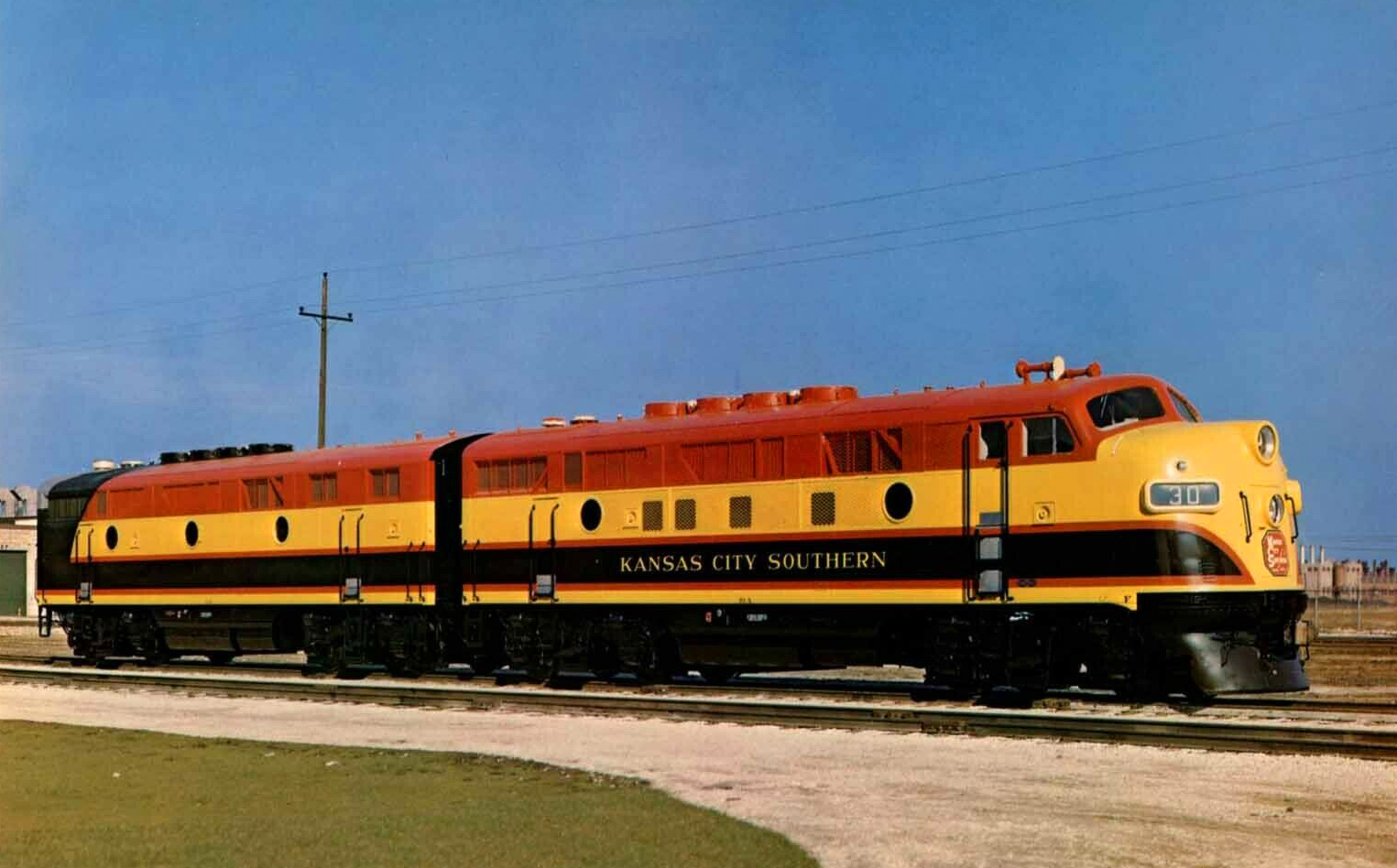 This Electro-Motive photo features a beautiful new set of Kansas City Southern F3's, #30-A and #30-B, in November, 1947. These units led the "Southern Belle" between Kansas City and Shreveport, Louisiana.
This Electro-Motive photo features a beautiful new set of Kansas City Southern F3's, #30-A and #30-B, in November, 1947. These units led the "Southern Belle" between Kansas City and Shreveport, Louisiana.In the end, when production had closed on the F3 some 1,111 F3As and 696 F3Bs had been manufactured between October, 1946 and February, 1949 when the first F7s were produced for the Rio Grande.
Nearly all of these units were built for U.S.-based railroads although Canadian National acquired four "A" units and two "B" units as noted in the above production roster.
They remained in service for years although most were gone by the 1970s as most had been sold or traded in for the later, and more powerful, F7 and F9 by that time.
Sources
- Foster, Gerald. A Field Guide To Trains. New York: Houghton Mifflin, 1996.
- Hayden, Bob. Diesel Locomotives: Cyclopedia, Volume 2 (Model Railroader). Milwaukee: Kalmbach Publishing Company, 1980.
- Marre, Louis A. Diesel Locomotives: The First 50 Years, A Guide To Diesels Built Before 1972. Milwaukee: Kalmbach Publishing Company, 1995.
- Pinkepank, Jerry A. Diesel Spotter's Guide. Milwaukee: Kalmbach Publishing Company, 1967.
- Solomon, Brian. EMD Locomotives. Minneapolis: MBI Publishing Company, 2006.
- Solomon, Brian. Electro-Motive E-Units and F-Units: The Illustrated History of North America's Favorite Locomotives. Minneapolis: Voyageur Press, 2011.
Contents
Recent Articles
-
Nevada - Wine Tasting - Train Rides
Dec 28, 25 03:26 PM
While it may not be the first place that comes to mind when you think of wine, you can sip this delight by train in Nevada at the Nevada Northern Railway. -
New Hampshire - Wine Tasting - Train Rides
Dec 28, 25 03:22 PM
This article details New Hampshire's most enchanting wine tasting trains, where every sip is paired with breathtaking views and a touch of adventure. -
Virginia - Murder Mystery - Dinner Train Rides
Dec 28, 25 12:23 PM
Among the state's railroad attractions, murder mystery dinner trains stand out as a captivating fusion of theatrical entertainment, fine dining, and scenic travel.

